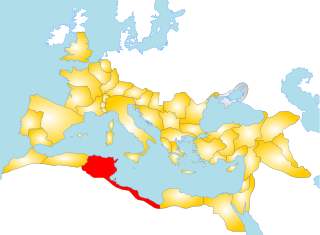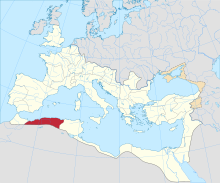
Cannae is an ancient village of the Apulia region of south east Italy. It is a frazione of the comune (municipality) of Barletta. Cannae was formerly a bishopric, and is presently (2022) a Latin Catholic titular see.
Boumedfaa a town in northern Algeria.

Absa Salla was a Roman and Byzantine-era town in the Roman province of Africa proconsularis. It was also the seat of a titular see of the Roman Catholic Church. with the same name. The location of the town remains unknown but is known to have existed for certain between 300 and 650AD.

Abbir Maius also known as Abbiritanus was a Roman and Byzantine-era civitas (city), later municipium, in the Roman province of Africa proconsularis.

Velefi was the name of an ancient town of Roman North Africa.

Abidda is the name of an ancient Roman city in the Roman province of Africa proconsularis or in late antiquity in the province of Byzacena. The exact location of the town is not known for certain but it was in northern Tunisia; the ruins at Henchir-Ksour-Abbeda outside of Semta (Dzemda) has been suggested as its location.
Drusiliana was a civitas (town) of Roman North Africa. Bingham called it a city of the Roman province of Mauretania Caesariensis. An inscription of Constantine the Great was found in the city ruins and it appears on the Tabula Peutingeriana The town has been tentatively identified with ruins near Khanguet-el-Kdim in northern Algeria. Located at 36.249547°N 8.907667°E. Epigraphical evidence suggest Constantine the Great undertook some works in the city in 312AD.

Sululos was a Roman era Municipium of the Roman province of Africa Proconsularis that flourished from which flourished from 30 BC - AD 640. The ancient town was officially known as Municipium Septimium Aurelium Severianum Apollinare Sululitanum and is tentatively identified with ruins at Bir-el-Heuch, (Bir-el-Ach) 36.461372, 9.605158 in what is today Tunisia.
Botriana is a locality and archaeological site in Tunisia

Gunela was an ancient Roman-Berber town and archaeological site in Bizerte Governorate, Tunisia. It was located at 37.165524n, 9.765536e, within the suburbs of Tinja, Tunisia.
Boreum was a city and diocese in Roman Libya. It is now a Roman Catholic titular see.

The Diocese of Bennefa is a home suppressed and titular see of the Roman Catholic Church. Bennefa, identifiable with Oglet-Khefifa in modern Tunisia, is an ancient civitas of the Roman province of Byzacena. and a seat of an ancient Christian episcopal see. The diocese was mentioned by Augustine of Hippo.

Cufruta was an ancient Roman-Berber civitas in the province of Byzacena. It was also the seat of a Roman Catholic diocese.

Edistiana was an ancient Roman–Berber city in the province of Africa Proconsularis and in late antiquity of Byzacena. It was located in the modern Tunisia. It was a former Catholic diocese.

Giru Mons is an ancient town of the Roman Empire and a titular bishopric of the Roman Catholic Church. The ancient town has been tentatively identified with ruins at Yerroum, northern Algeria.
Voncariana was an ancient Roman–Berber civitas in the province of Mauretania Caesariensis. Its stone ruins are located at Boghasi in modern Algeria.
Castellum Tatroportus, also known as Tatroporto Castle or Latin: Diocesis Castellotatro-Portensis, was a Roman–Berber civitas and former Roman Catholic diocese that flourished through the Vandal and Roman eras and into late antiquity. It was located in the province of Mauretania Caesariensis in Africa Proconsulare, though an exact location has not been identified.
The Diocese of Noba is a former Christian diocese located in present-day Algeria. It is currently a Catholic titular see.

Marazanae was a Roman town of the Roman province of Byzacena during the Roman Empire and into late antiquity.

The diocese of Dionysiana is a suppressed and titular see of the Roman Catholic Church.





